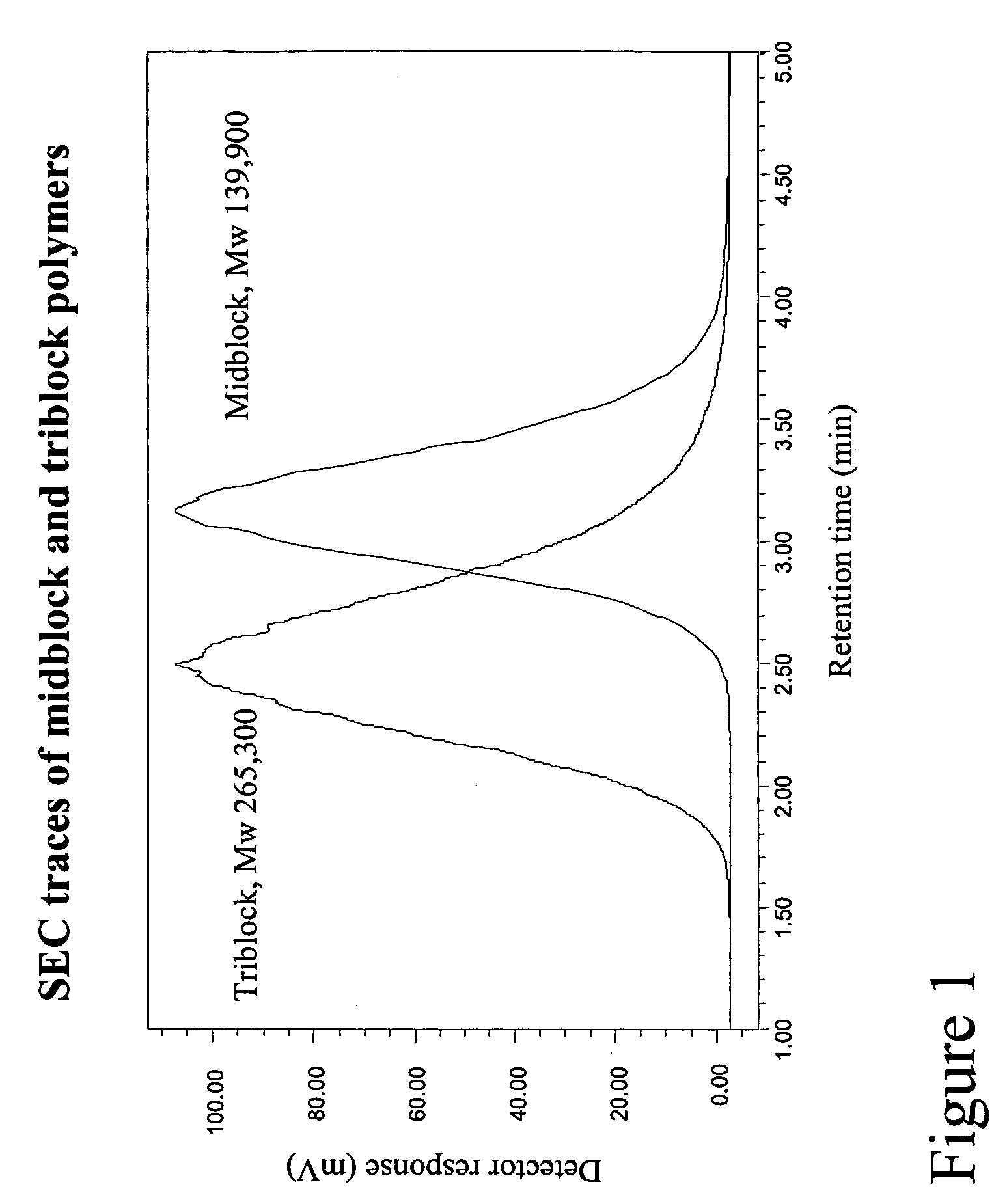Methods of making ABA-type block copolymers having a random block of hydrophobic and hydrophilic monomers
- Summary
- Abstract
- Description
- Claims
- Application Information
AI Technical Summary
Benefits of technology
Problems solved by technology
Method used
Image
Examples
example 1
[0075]This example shows the synthesis of the bis-initiator control agent adduct that was used in the subsequent polymerization experiments, generally following scheme
[0076]
[0077]Compound 1 was prepared according to a literature procedure (Hawker et al, J. Am. Chem. Soc., 1999, 121(16), 3904–3920, which is incorporated herein by reference). Compound 1 (10.0 g, 26.74 mmol), bis-phenol 2 (2.98 g, 13.05 mmol), potassium carbonate (18.48 g), 18-crown-6 (0.50 g) and acetone (250 mL) were mixed and heated at reflux for 18 hours, then cooled to room temperature. The reaction mixture was filtered and evaporated, and the residue was partitioned between dichloromethane (200 mL) and water (200 mL). The organic layer was separated, dried with sodium sulfate, and evaporated to dryness. The crude product was purified by flash chromatography, affording the product as a white solid (7.50 g).
examples 2 – 7
Examples 2–7
[0078]These examples show preparation of ABA block copolymers using the bis-initator control agent prepared in Example 1. In each of these examples, the free radical nitroxide is
[0079]
The free nitroxide was prepared according to literature procedures published by Hawker et al., Id. The preparation follows the general procedure below.
[0080]Preparation of B block
[0081]Bis-initiator (0.100 mL, 28.1 mg / mL solution in MEA), MEA (0.0922 mL) and free nitroxide (0.0078 mL, 0.88 mg / mL solution in MEA) were mixed in a 1 mL glass vial under argon, and heated at 125° C. with vigorous stirring for 6 hrs, then cooled to room temperature. The conversion was 80% as measured by 1H-NMR.
[0082]Preparation of triblock copolymer (ABA)
[0083]To the polymerization mixture above, DMA, diglyme (0.2 mL) and free nitroxide (0.0777 mL, 0.88 mg / mL solution in diglyme) were added. The amount of DMA varied from 0.108 mL to 0.491 mL depending on examples. The mixture was heated at 125° C. for 14 hours, t...
examples 8 – 21
Examples 8–21
[0085]Examples 8–21 generally follow the procedures below.
[0086]Preparation of random B block
[0087]Bis-initiator (0.4167 g, 0.461 mmol from Example 1), MEA (27.00 g, 207.47 mmol), tert-butyl acrylate (2.95 g, 23.02 mmol) and free nitroxide (2.03 mg, 0.00923 mmol) were mixed in a 100 mL flask under argon, and heated at 125° C. with vigorous stirring for 5 hrs, then cooled to room temperature. The conversion was 72% for both monomers as measured by 1H-NMR. The reaction mixture was dissolved in acetone (50 mL), and precipitated into hexane (500 mL). The polymer was collected and dried under vacuum at 45° C., affording a clear viscous liquid (21.41 g).
[0088]Preparation of triblock copolymer (ABA)
[0089]B block polymer (15.0 g), diglyme (15 g), DMA (76.15 g) and free nitroxide (1.78 mL, 2.0 mg / mL solution in diglyme) were mixed in a 500 mL flask under argon. The mixture was stirred and heated at 125° C. for 7 hrs, then cooled to room temperature. The mixture was dissolved in ...
PUM
| Property | Measurement | Unit |
|---|---|---|
| Density | aaaaa | aaaaa |
| Current | aaaaa | aaaaa |
| Solubility (mass) | aaaaa | aaaaa |
Abstract
Description
Claims
Application Information
 Login to View More
Login to View More - R&D
- Intellectual Property
- Life Sciences
- Materials
- Tech Scout
- Unparalleled Data Quality
- Higher Quality Content
- 60% Fewer Hallucinations
Browse by: Latest US Patents, China's latest patents, Technical Efficacy Thesaurus, Application Domain, Technology Topic, Popular Technical Reports.
© 2025 PatSnap. All rights reserved.Legal|Privacy policy|Modern Slavery Act Transparency Statement|Sitemap|About US| Contact US: help@patsnap.com



